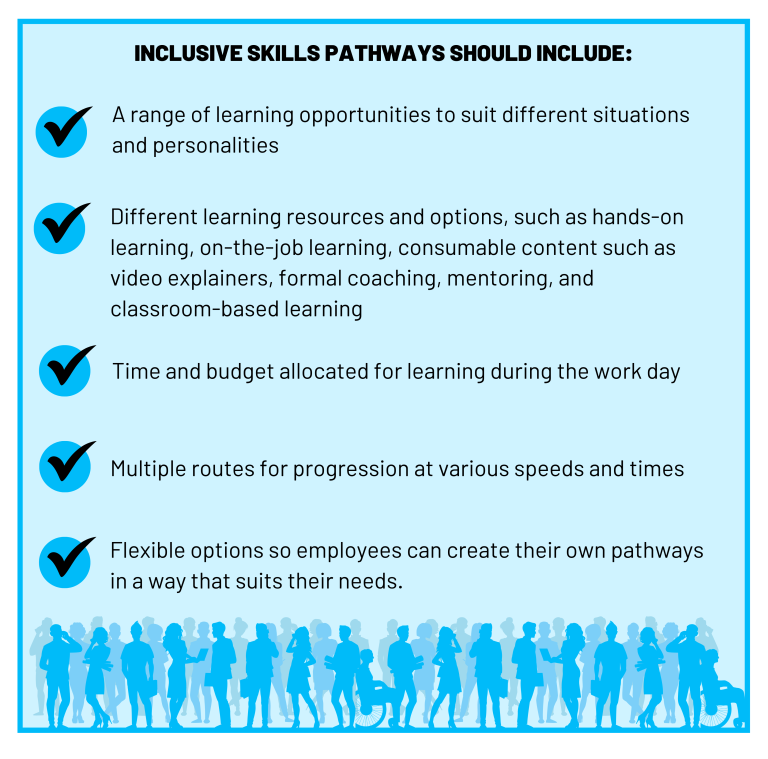Inclusive Skills Development in the Age of AI
Home » Progressing Women In Tech Report

Building Tomorrow’s Workforce: Inclusive Skills Development in the Age of AI
The world is hurtling towards a digital skills crisis as the pace of AI development continues to accelerate, transforming an estimated 1 billion jobs over the next decade. The scale and scope of that innovation is incredibly exciting but underscores the need to keep diversity in mind. Without diverse input, we run the risk of coding the biases that exist across society into our social, commercial and political infrastructure.
Women want to play a greater role in the evolution and adoption of AI, but we need to empower them with the skills they need to do so. In our latest report, produced in partnership with the Tech Talent Charter, Code First Girls reveals how to build inclusive skills programmes and explains why a commitment to ongoing development for all will become the competitive advantage for businesses that thrive in the fourth industrial revolution.
Read on to discover our top 10 recommendations for employers ready to reshape how they think about tech, skills and career development, or download the report below.

Code First Girls

Tech Talent Charter

CHAPTER ONE: Upskilling and reskilling as a business imperative
UPSKILLING & RESKILLING
AS A BUSINESS IMPERATIVE
UPSKILLING & RESKILLING
AS A BUSINESS IMPERATIVE
NO LONGER JUST A HR ISSUE
NO LONGER JUST A HR ISSUE

Middle managers can sometimes be reluctant to support training efforts because they’re worried they won’t be able to keep up with their regular responsibilities while being reskilled. They may also not want to lose people from their teams, leading to so-called ‘talent hoarding’. This limits an employee’s professional progression, reduces productivity and morale, and impacts business growth overall.

There are great benefits for morale, retention and loyalty if upskilling and reskilling is done right. Data from the Boston Consulting Group found 68% of workers are aware of coming disruptions in their fields and are willing to upskill or reskill to remain competitively employed.

Learning and development has long been seen as a sidelined employee perk (that may or may not be used), and the responsibility of HR rather than a strategic imperative. According to an analysis by Boston Consulting Group, only 24% of companies put skill-building efforts in the context of corporate strategy.
This is now becoming even more urgent, particularly for minorities. With the half-life of some technical skills now less than 2.5 years, and women 40% more likely to have their work replaced by AI automation, technology leaders that do not make upskilling initiatives a strategic priority may find they lock even more women out of the sector.
EMPLOYEES WANT TO UPSKILL
EMPLOYEES WANT TO UPSKILL
Where training budgets do exist, employees are not empowered to use them strategically. Efforts are often generic, lack structure and do not relate to KPIs. Employees may not be allocated the time or headspace for intensive learning, and therefore prioritise other tasks above their own professional development.
What that looks like is changing. According to the Tech Talent Charter (TTC), nearly twice as many tech workers now obtain their skills through non-traditional tech skills programmes. That’s particularly true for women who are more likely than men to be learning on the job (28% vs 18%).

THE IMPACT ON EMPLOYEE RETENTION
THE IMPACT ON EMPLOYEE RETENTION
Reskilling and upskilling can boost retention by opening up opportunities for employees across the board. Almost eight in 10 (78%) of TTC’s survey respondents said they wouldn’t have been able to secure their current role without tech training, emphasising the importance of such programmes in the UK’s digital skills strategy.

Similarly, Code First Girls found 81% of career switchers said upskilling opportunities would have encouraged them to stay in their original role.
RESKILLING IS GOOD FOR DIVERSITY
RESKILLING IS GOOD FOR DIVERSITY
Reskilling can also boost diversity at all levels of the organisation. The Tech Talent Charter found just 21% of senior tech role holders are gender minorities. But when asked, signatories say they’re held back by low diversity in the talent pool.
When questioned further, 4% said this was caused by a lack of training, or a lack of available diverse talent with the correct skillset. By boosting reskilling opportunities for women in technology, that talent pipeline would be vastly improved.

By investing in reskilling around AI, women can also be supported to stay in technology careers longer than they would otherwise (eventually reaching higher levels of management).
Women in tech are statistically more likely than men to suffer from burnout. Research by Harvard Business Review has found women are 48% more likely to volunteer for non-promotable activities compared to men, and are assigned them by managers 44% more of the time.
These tasks, described as “glue work” by Tanya Reilly, the author of The Staff Engineer’s Path and a senior principal engineer at Squarespace, include routine administrative work, writing documents, improving team processes, and establishing coding standards.
Using AI to streamline workloads and automate repetitive tasks can help alleviate some of the pressure women in tech face at work, and leave them free to focus on higher level, more intellectually stimulating, work.

CHAPTER TWO: Three steps to build inclusive skills programs
THREE STEPS TO BUILDING
INCLUSIVE SKILLS PROGRAMMEs
THREE STEPS TO BUILDING
INCLUSIVE SKILLS PROGRAMMES

Workforce planning helps strategically align a company’s workforce with its objectives, by forecasting future workforce requirements and identifying gaps that currently exist. Skills mapping focuses on understanding the specific skills, knowledge and abilities individuals have, or those which are required for desired roles. It aims to ensure a company has the necessary capabilities to achieve its objectives.
Leaders should take stock of the capabilities their workforce already has by talking to employees. Make sure to include any experience from previous jobs, complimentary proficiencies, and other interests outside the parameters of their current job descriptions. It’s also worth considering their future aspirations and any potential obstacles they feel would prevent them from engaging with progression opportunities.
UNLOCK AI-POWERED PLANNING TOOLS
AI-powered workforce planning and skills intelligence tools can also help to build a clear picture of the organisation’s current strengths and gaps, forecast future staffing needs, identify priorities for skills development, and reveal how to make the best use of the talent available.
This engagement with employees will help leaders shift how they think about and promote initiatives around upskilling and reskilling. There may be some employee anxiety around job changes or losses, for example, with the expansion of AI. Manager changes, professional risks and personal costs should also be taken into consideration.


Once leaders know what skills they have within their teams and those they need, they must create structured pathways with support and resources to help all employees get there.
They also need to be inclusive. A diverse workplace has more access to different points of views, skill sets, creative visions and experience.

Research by the Tech Talent Charter found women are more likely to report learning on the job as their primary method of gaining tech skills (28%) compared to men (18%).
Being self-taught also rates highly. However, because women undertake the majority of caring responsibilities at home, many are unable to undertake self-led learning outside of work hours. Therefore time must be given for professional development to happen at work. Mentoring and buddy systems can also be beneficial by encouraging collaboration, microskilling and continuous learning.


When Satya Nadella took over Microsoft in 2014, he shifted the tech giant’s focus from being a group of “know-it-alls” to “learn-it-alls”. Experts credit the move with a subsequent tripling of the company’s value.
Without buy-in at the top, it’s hard for even the best reskilling programmes to succeed. This needs to be made an ongoing priority that receives considerable investment. Senior leaders must advocate the benefits of reskilling on a company’s strategy and ensure that management teams throughout the company understand their shared responsibility for making this happen. Those who prioritise their own professional development also set a powerful example for the rest of the team.
Measure and report on the ROI of a skills framework internally to share the success and benefits of the approach. That may include comparing with metrics such as the cost of hiring, attrition and loss of institutional memory, as well as showing an uplift in employee engagement and morale, productivity and speed to readiness. Introducing KPIs around training – both for middle managers individually and measuring the takeup from their teams – will also help to keep everything on track.
Alongside instilling a culture of continuous learning, organisations will need to create a sense of psychological safety whereby employees are supported to take risks, to openly share ideas, and to feel belonging and inclusion.
Research by McKinsey found that psychological safety can only be achieved at scale when a company’s most senior leaders develop and embody the behaviours they want to see across the business, such as skills development.
CHAPTER THREE: The cultural shift beyond skills
THE CULTURAL SHIFT THAT
GOES BEYOND SKILLs
THE CULTURAL SHIFT THAT
GOES BEYOND SKILLS

With the implementation of effective upskilling and reskilling initiatives, organisations must transform their recruitment strategies, prioritising skills over traditional qualifications like degrees and work experience. As automation takes over routine tasks, skills such as creativity, critical thinking, emotional intelligence, and communication will surge in value, complementing AI capabilities.

This shift towards skill-centric recruitment fosters a dynamic landscape where roles become more flexible, with talent allocated to projects as needed. Career switching across sectors may rise, particularly benefiting women who historically faced barriers to entering tech-related fields.
TAKING A SKILLS AND CAPABILITY-BASED APPROACH
TAKING A SKILLS AND CAPABILITY-BASED APPROACH
Retraining opportunities are pivotal, evidenced by the significant increase in applicants seeking career shifts and growing interest from organisations in supporting internal career transitions, reflecting a need for adaptability and openness within organisations.
Alongside instilling a culture of continuous learning, organisations will need to create a sense of psychological safety whereby employees are supported to take risks, to openly share ideas, and to feel belonging and inclusion.

This shift towards skill-centric recruitment fosters a dynamic landscape where roles become more flexible, with talent allocated to projects as needed. Career switching across sectors may rise, particularly benefiting women who historically faced barriers to entering tech-related fields.
NURTURING SQUIGGLY CAREERS
NURTURING SQUIGGLY CAREERS
McKinsey estimates up to 375 million people will need to switch occupation categories by 2030, and up to 50 million new technology jobs will be created. In the future, it’s unlikely that career paths will progress in a linear fashion throughout an organisation or sector.
Empowered by skills programmes, workers will become T-shaped employees, capable of moving fluidly between roles, and building squiggly careers that are full of opportunity.

Managers will need to be trained in inclusive leadership, so they can help employees apply their new skills effectively. That training should include empathy, active listening, and how to advocate for colleagues outside of their functional areas. Employees may also need a longer, more structured onboarding experience when they move into a new role (whether they’ve been recruited internally or externally) while they find their feet.
Finally, leaders should showcase and celebrate non-linear career narratives, particularly those that have accelerated or plateaued at different times, to encourage others to take the leap.

CHAPTER FOUR: It takes a village: Real world examples

THE ROI OF INCLUSIVE HIRING WITH CAREER SWITCHERS
THE ROI OF INCLUSIVE HIRING WITH CAREER SWITCHERS
Since their pilot launch in 2021, NatWest has increased their program with Code First Girls by six fold. They have hired 130 career switchers and sponsored over 6,000 women to learn how to code, including sponsoring displaced Ukrainian women on the CFGdegree in 2023.

In building pipelines of skilled career switchers, NatWest have saved in talent acquisition costs, and reduced time to hire by up to six months. The company has found Code First Girls graduates are twice as productive in their first year compared to the ‘internal’ reskilling programmes currently underway. They find career switchers to be hungry, driven, and bring soft skills and experience meaning that they progress quickly within the business.
NatWest now upskill employee cohorts with the Code First Girls curriculum. Enabling progress their teams in core and specialised tech skill areas.
CONCLUSION AND
FINAL RECOMMENDATIONS
CONCLUSION AND
FINAL RECOMMENDATIONS
STARTING YOUR JOURNEY
STARTING YOUR JOURNEY
Building and implementing inclusive skills pathways isn’t something that can be achieved overnight. Working with the right partners can help. Groups with experience in inclusive training can assist by conducting joint training efforts, help leaders measure impact, and facilitate the scaling of a programme up and down as required.
Finally, leaders should showcase and celebrate non-linear career narratives, particularly those that have accelerated or plateaued at different times, to encourage others to take the leap.
AI & LEARNING SYSTEMS WILL HELP TO FACILITATE
AI & LEARNING SYSTEMS WILL HELP TO FACILITATE
Organisations need to put inclusive learning systems in place now to empower their employees for the future of work. AI is already being put to use at scale and its influence will only expand.
We need diverse teams capable of evolving alongside that technology to maximise their potential. This isn’t just about corporate productivity and growth at the expense of our people, but one that empowers all of them to fulfil the vast expanse of their potential.
CHAPTER FIVE: TOP 10 RECOMMENDATIONS
TOP 10
RECOMMENDATIONS
TOP 10 RECOMMENDATIONS
- Prioritise skills mapping
Determine what skills you have within the workforce and identify roles you’ll need for the future in line with the overall business objectives and strategy. - Treat employees as partners
Involve them in the creation of reskilling programmes, ask about their aspirations, and match training with new career opportunities to boost interest. - Think about how your employees want to learn
Include flexible learning options that suit people’s different needs, and provide time and space for training on the job. - Reshape recruitment processes
Consider softer skills, adjacent skills, and career switchers when hiring or promoting internally. - Encourage buy-in from middle managers
Make career development and progression the responsibility of every leader, measure and evaluate what’s working, and introduce KPIs to keep everyone on track. - Involve senior leaders
Provide them with sensitivity and bias recognition training, encouraging that they lead by championing success stories internally and being transparent in HR processes - Set ethical guidelines
Set policies regarding the use of AI tools in the workplace, keeping inclusion and diversity in mind. - Build psychological safety
Create a culture of continuous learning and psychological safety. Cultivate an atmosphere where employees feel comfortable taking risks, expressing their opinions, and can “fail fast” without judgement. - Hire for potential
Shift your focus from credentials to identifying and valuing relevant skills and potential in candidates. Select individuals based on their demonstrated abilities and capacity to grow and adapt within the role or organization. - Choose a partner that can help conduct training
Tap into more diverse talent pools, measure impact, and scale efforts as required. Make sure it’s one that shares your values on diversity and inclusion.


















